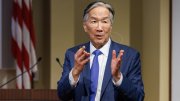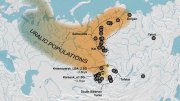For those outside Silicon Valley, the “Internet of Things” is a buzzword often associated with seemingly superfluous toys for early-adopting consumers: the expensive Apple watch, the oft-ridiculed Google Glass, or a “smart” refrigerator that senses when the milk jug is empty. So when Sarnoff professor of business administration Marco Iansiti began looking at how businesses have been transformed by the growing number of everyday objects connected to the Web, the first questioned he asked was: Is the hype real?
For Iansiti and associate professor of business administration Karim R. Lakhani, the answer is an unequivocal yes. We have entered an age of “Digital Ubiquity,” they wrote in Harvard Business Review (HBR) last fall. Sensors in gadgets, appliances, and machines generate an unprecedented and growing volume of data that is increasingly easy to share wirelessly. The ability to aggregate and analyze these data at a massive scale, the authors argue, has begun to change the very nature of how businesses create value and make money in nearly every industry.
The researchers point to recent efforts at General Electric that have turned the century-old company into an unexpected digital-transition success story. In the last few years, GE and other electronics companies have seen exponential growth in the volume, velocity, and variety of data that they collect, Lakhani explains, forcing “companies that did not think that they were in the software business to become good at software development.”
As a result, GE began to take stock of the software underpinning its widely varied product lines. The company’s 12,000 software professionals were working on 136 different products, each with its own underlying technical platform, but only 17 of these were profitable. In an effort to streamline this work, in 2011 the company launched a new business unit, GE Software, a centralized office to develop one underlying program for all its devices.
The “industrial internet” is the term GE executives have coined to refer to these digital integration efforts. The corporation’s new approach to selling wind turbines exemplifies the opportunities and challenges that this connected future presents. Before the world went digital, the easiest way for GE to add value to a customer’s wind farm was to sell it more turbines. Now sensors wirelessly transmit data on performance and maintenance back to GE, which can replace worn-out parts before they break and adjust controls for torque, pitch, and speed in real time. By keeping the turbines running more efficiently, GE has created worth without selling more products—and a new price model allows the company to capture part of this value. Rather than charging for the turbine alone, the sales force can quantify the wind farm’s data-driven savings and charge a fee based on the value of that optimization. These new ways of creating and capturing value have gone hand in hand with fundamental changes in GE’s operations. The company has invested billions in GE Software, and retrained its sales force to focus on long-term contracts and pay-for-performance.
GE’s example underscores why the Internet of Things—a widespread form of digital disruption—need not be a death knell for large, legacy companies. New business models can be built on the loyalty that GE has spent decades building among its customers. “These assets are amazingly powerful, and if you can just find a way to unlock them, it becomes a great advantage,” Lakhani says. But monetizing such assets “requires new business models.”
For the past two years, Lakhani and Iansiti have taught a popular new elective course on digital innovation, and they’re writing a book on the subject. The main takeaway, they say, is that these transitions are blurring the boundaries that once cordoned off the tech industry.
Take the highly publicized case of Nest, the connected thermostat company that Google bought for $3.2 billion in 2014. Nest offers customers convenience: smartphone users with remote access need never again wonder whether they turned down the heat before they left for vacation. By giving individuals more dynamic control over energy usage, Nest helps customers save—potentially disrupting the traditional, $3-billion thermostat market. But from Google’s perspective, Lakhani and Iansiti wrote in HBR, Nest creates value that goes far beyond just the sum of the savings on each person’s energy bill. Google has, more significantly, bought access to an unparalleled data set about how energy is generated, consumed, and wasted—an opening into a $6-trillion energy sector (see “The Risk of Inaction,” May-June 2015).
The Internet of Things promises to change the way consumers live. But the industrial shift—forcing companies far beyond Silicon Valley to join the tech world—might be even more significant.









